A little while back, Dr Andrew Huberman, a Stanford neuroscientist with a massive podcast, released an episode called “How to Improve Skin Health & Appearance”. It had a bunch of slightly weird recommendations if you’re familiar with skincare science. He mentioned some of his sources, but didn’t have any experts talking.
1.5 months later, he released another skin episode, this time with a dermatologist and skin cancer surgeon, Dr Teo Soleymani. And a lot of the recommendations started making more sense to me, but not necessarily in a good way…
The full video is here (it should be listenable as a podcast instead if you prefer), the text version continues below and is broken up into multiple parts.
This has been one of my most requested topics, and it ended up being my longest YouTube video at 2 hours. The two Huberman episodes added up to 5 hours and 14 minutes – in Lord of the Rings units, that’s the whole of the first movie, and almost to the end of the second movie, just two minutes before Gimli says “Toss me”, if you’re watching the original theatrical releases and skipping the credits.
I tried to organise it by topic to make it more digestible, since some were addressed in both episodes. I also tried my best to capture the gist of what they were saying in the quoted sections.
I had no strong feelings either way about Huberman or the dermatologist before hearing their opinions on skincare, and interacting with them online. I hadn’t really looked into Huberman much until people started asking me about his comments on sunscreen.
Bad advice in my specialty area annoys me a lot. I’ve followed bad skincare advice, and I used to be a moderator on the Skincare Addiction subreddit, so I’ve seen lots of other people following bad advice. It’s a huge waste of time and money – there’s so much BS surrounding skincare already, I really don’t think we need scientists adding to that.
A lot of the stuff in the episodes is largely correct, as far as I can tell. I’m skipping a lot of the dermatology/skin disease stuff since it’s not my forte (maybe a dermatologist can comment on it). I’m not going to nitpick little errors too much (people say the wrong word when speaking off the cuff) – I’m going to focus on the big issues, and the recommendations, which is really where I think it goes a bit pear-shaped.
Sun protection
“There is clear evidence that sunlight can cause skin cancers.”
“I want to highlight the fact that there’s very little controversy as to whether or not UV light can cause mutations in cells.”
“I’m not somebody who thinks that sunscreen has no value. In fact, quite the opposite under certain conditions and certain sunscreens. I want to say that for the record.”
– Huberman Lab, “How to Improve Skin Health and Appearance”, 1 July 2024 [Solo Skincare Episode]
Sunscreen was how I first came across Andrew Huberman – there was a viral clip of him warning against chemical sunscreens, which I broke down in another video. That led to a lot of people saying that Huberman didn’t recommend sunscreen, and since he was a Stanford professor with a massive following, no one should wear sunscreen. So I do really appreciate him being so clear about addressing this in the episode.
We tend to think of skin cancer as no big deal, but I recently watched a documentary called Conquering Skin Cancer which was really eye-opening. After the cancer’s been removed, some people have to get treatment every 2 weeks for the rest of their lives. One woman had an eyebrow removed twice, and her neck was grafted to replace her cheek – she had special therapy to reprogram her brain into sensing it as her cheek. The skin cancer spread into another person’s lymph node, which burst and sent the cancer into his blood. It’s not always something you can easily brush off.
“Many people believe that if they didn’t get a sunburn, they are not at additional risk for inducing skin cancer or other issues with skin, right? We’re not just talking about skin cancer, we’re talking about accelerated aging of the skin according to sun exposure.” – Solo Skincare Episode
Again, lots of credit to him for this important message. The evidence is very clear: intense sun exposure that leads to a sunburn is bad, but skin damage from intermittent sun exposure is cumulative.
In the Nambour trial (THE most famous randomised clinical trial on sunscreen), people who wore daily sunscreen consistently had less skin cancers and skin aging than those who wore it normally – to places like the beach, where they were likely to burn.
After 4.5 years of daily sunscreen, the main findings were:
- No detectable increase in skin aging with daily sunscreen after 4.5 years
- 24% less likely to show increased aging
- 40% reduction in SCC tumours during trial
- New SCC and SCC incidence about one-third lower 8 years later
- 22% reduction of actinic keratoses in first 2 years
- Invasive melanomas reduced by 73% over 15 years
- Average invasive melanoma thickness 0.53 mm with daily sunscreen vs 1.2 mm
This study from the 1990s used an SPF 16 sunscreen that didn’t look properly photostabilised (it contained 8% octinoxate and 2% avobenzone as the sunscreen filters), so the sunscreens we have now will have a bigger impact.
But then we get into the specifics of sun protection and sunscreens. The misunderstandings presented here are pretty widespread, even with medical doctors and dermatologists, and scientists who aren’t as familiar with this area. This is going to get a lot worse over the next few years because US regulations are kind of ass backwards about this, so this is a good time to discuss it.
Physical barriers
Before discussing sunscreen, he talks about “physical barriers” as an alternative for people worried about chemicals:
“If you’re just one of these people that does not want to put sunscreen on, because you’re very concerned about whatever chemical might be in sunscreen. Well then, consider that the physical barrier of an article of clothing or a hat or a bandana of sorts, can indeed shield you from the sun to some degree, often to a great degree. And again I don’t think there’s any controversy as to whether or not those are safe.” – Solo Skincare Episode
He also brings up physical barriers a bunch in the second episode:
Andrew Huberman (AH): And maybe for the moment, let’s just set aside sunscreens and acknowledge that a physical barrier like hat, long sleeves, long pants provides a pretty good barrier to the sun. Correct?
Teo Soleymani (TS): Yeah. In fact, physical barriers like shade, clothing, hats have been shown to be more effective, um, than topical sunscreens for several reasons.
AH: Another call for the mineral based sunscreens just as a, you know, why, why take the risk?
TS: Or even, you know, shade hat clothing. You know, if you’re really worried about putting something on an absorption, you get excellent protection by natural barriers.
It’s also in one of the two Instagram posts he used to promote this episode: “No one debates a physical barrier.”

I kind of get it – you want to give people a solution if they’re never going to wear sunscreen. But if it’s presented like an easy alternative with zero downsides, a lot of people will go for it – none of the limitations of physical barriers are discussed. I’m not sure if Huberman or the dermatologist know how big some of these downsides are (I certainly didn’t before looking into the research properly). I think if they did, and they also realised how safe sunscreens are, the cost-benefit calculus would be different, and maybe they wouldn’t have leaned into physical barriers as much.
Shade
First off, hats and shade are great, but a bit deceptive.
Shade doesn’t necessarily give great protection because of scattering. You can still see objects in the shade because visible light isn’t just coming straight from the sun – it’s also scattered off air molecules high up in the sky. It’s a lot darker in the shade than in the sun, but there’s still light entering.
But UV scatters a lot more – UVB (the short wavelengths that cause more damage) scatters about 10 times more than visible light. So the amount of UV damage you’re getting in the shade is roughly 10 times more than you’d expect, based on how visibly dark it is. This is why you can still get sunburnt in the shade.
Related post: Do Hats and Umbrellas Protect Well From the Sun?
A good way of estimating how much scattered UV you’re getting is sky view. Basically if you’re in the middle of a field, very roughly 40% of the UV you get is directly from the sun, while 60% is scattered from the sky (the exact percentages depend on things like latitude and wavelength but the key point: direct sunlight can account for less than half of your total UV).
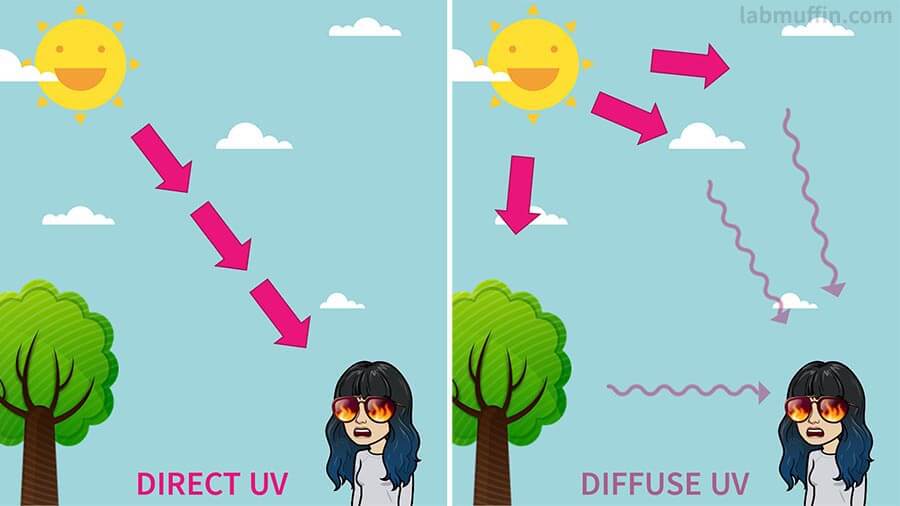
For the ~60% from the sky, the amount is proportional to the amount of sky you see:
- If you’re in the middle of a field, you’re seeing 100% of the inside of a dome of sky.
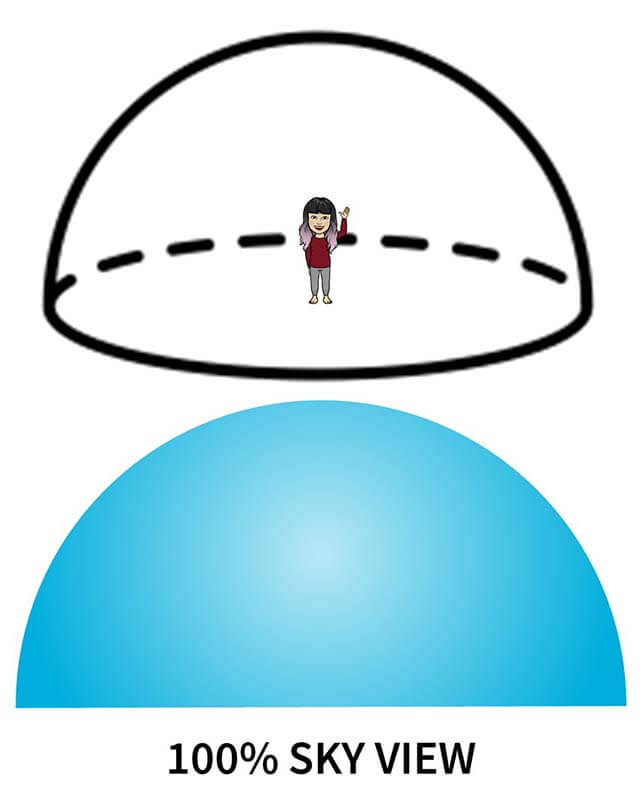
- If you’re completely in the shade of a tiny umbrella that just blocks out the sun, with zero sunshine directly hitting your skin, you’re still getting 60% of the total UV.
- If you’re standing right next to a house and you’re completely in the shade, you’ve blocked out half the sky, so you’re getting 30%. That means you’re still getting about one third of the UV you were getting in the middle of the sunny field! And this can be extra deceptive, because you won’t feel anywhere near as hot.
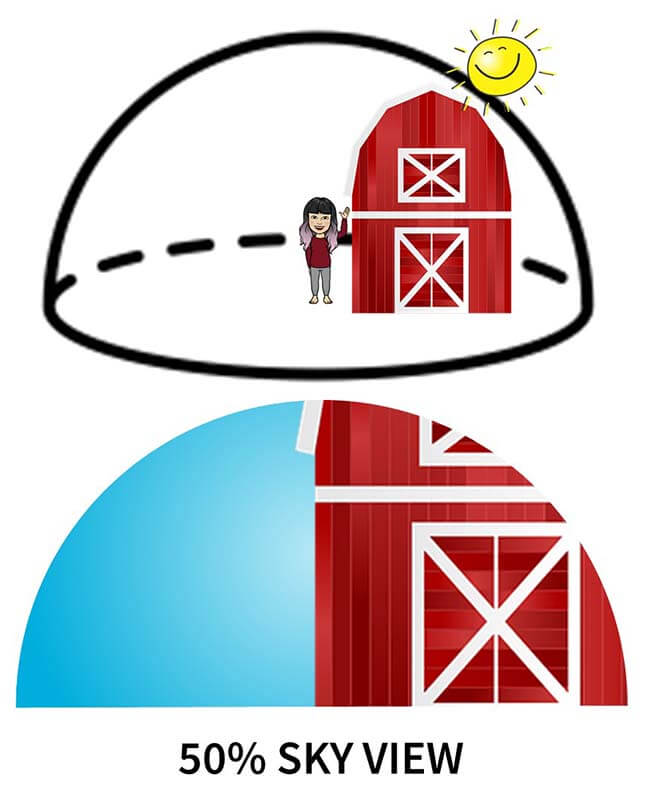
Hats
Hats don’t block out a ton of sky. There’s also UV being scattered from the ground, and surfaces around you.
One study looked at an Akubra Drover hat – over a year, forehead UV was reduced to 1/7, nose UV was 1/3, but the cheek was still getting more than half the UV compared to no hat. That fraction is how SPF works, so on average, the hat was giving SPF 2 to 6. That’s pretty low compared to sunscreen – and this is a pretty big hat unlike, say, a baseball cap.
Related post: Do Hats and Umbrellas Protect Well From the Sun?

Clothing and fabric are also great but again, there are limitations. The main one is that when UV is high, it’s usually hot, and the sorts of natural, light coloured, airy fabrics you’d want to wear don’t block much UV. For example, about two thirds of the white fabrics tested in this study had less than UPF 15.
Related post: How to Choose UV Protective Clothing
Of course, sunscreen has downsides too. You use it up much faster than hats or clothing, you need to reapply, it’s easy to skip spots, and most people don’t apply enough.
Related post: Answering (Almost) Every Sunscreen Question
So we shouldn’t think of it as hats versus clothing versus sunscreen – it’s really hats plus clothing plus sunscreen, plus shade and sunglasses. This is the messaging that’s been used in Australia for a long time:
- SLIP on a shirt
- SLOP on some sunscreen
- SLAP on a hat
- SEEK shade
- SLIDE on sunglasses
I went to an interdisciplinary sun protection conference in Queensland recently, the skin cancer capital of the world (I actually did a plenary talk) – many of the sun protection researchers really emphasised this layering, Swiss cheese approach.

References
Green A, Williams G, Neale R, et al. Daily sunscreen application and betacarotene supplementation in prevention of basal-cell and squamous-cell carcinomas of the skin: a randomised controlled trial. Lancet. 1999;354(9180):723-729. doi:10.1016/S0140-6736(98)12168-2
Green AC, Williams GM, Logan V, Strutton GM. Reduced Melanoma After Regular Sunscreen Use: Randomized Trial Follow-Up. J Clin Oncol. 2011;29(3):257-263. doi:10.1200/JCO.2010.28.7078
Van Der Pols JC, Williams GM, Pandeya N, Logan V, Green AC. Prolonged Prevention of Squamous Cell Carcinoma of the Skin by Regular Sunscreen Use. Cancer Epidemiol Biomarkers Prev. 2006;15(12):2546-2548. doi:10.1158/1055-9965.EPI-06-0352
Darlington S, Williams G, Neale R, Frost C, Green A. A Randomized Controlled Trial to Assess Sunscreen Application and Beta Carotene Supplementation in the Prevention of Solar Keratoses. Arch Dermatol. 2003;139(4). doi:10.1001/archderm.139.4.451
Hughes MCB, Williams GM, Baker P, Green AC. Sunscreen and Prevention of Skin Aging: A Randomized Trial. Ann Intern Med. 2013;158(11):781. doi:10.7326/0003-4819-158-11-201306040-00002
Wong JCF, Airey DK, Fleming RA. Annual reduction of solar UV exposure to the facial area of outdoor workers in Southeast Queensland by wearing a hat. Photoderm Photoimm Photomed. 1996;12(3):131-135. doi:10.1111/j.1600-0781.1996.tb00189.x
Davis S, Capjack L, Kerr N, Fedosejcvs R. Clothing as protection from ultraviolet radiation: which fabric is most effective? Int J Dermatology. 1997;36(5):374-379. doi:10.1046/j.1365-4362.1997.00046.x
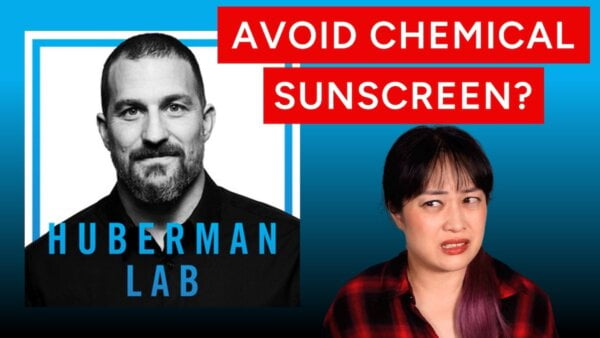
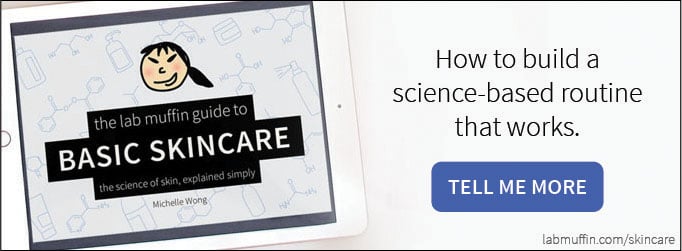
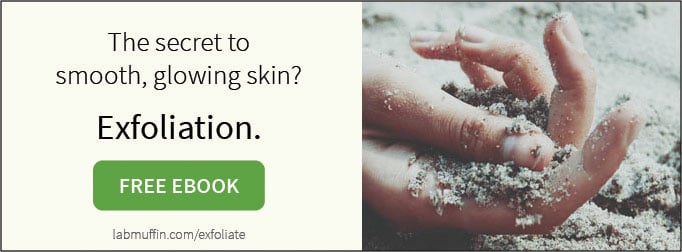
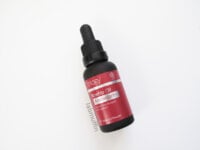
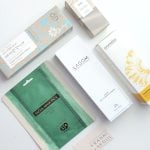
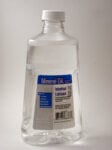

Hi Dr Michelle! I’m a big fan! Would you ever think about doing a video or blog post listing other creators who are like you? It’s so hard to know who to trust, even creators that are like wearing scrubs and say they’re doctors, how can I know who’s saying something real and who’s trying to sell me some expensive lies? I wish there were some trustworthy creators in the diet/fitness community who do what you do. Like what the hell is laser lipo and why do some people naturally prefer chicken breast over french fries but not me? The amount of conflicting information out there is so overwhelming. Thank you for being someone who cuts through the noise and gives science backed evidence
Hi Michelle,
I think VT Reedle shots would make an extremely interesting topic. And the product is ultra viral and popular too.
I’ve seen online that the sea sponge is similar in shape to asbestos under a microscope. Where does the science lie?
And, aside from the possible carcinogenic implications, are there potential issues with the particles building up in the lungs or eyes?
And finally, how do they have such a smoothing effect? Is it simply just causing a temporary swelling to skin that smoothes out texture?
Thank you so much. I love what you do. I refer so many friends to your site for some science based sense!! Thank you 🙂
Hi 🙂 This was really interesting! I wish people would stop demonising chemical sunscreens already, as a biochemist I also find it really annoying!
I’ve been watching your videos for quite a while now and I always find them so interesting and well researched.
I know this isn’t relevant to this particular article, but I’ve always heard your many recommendations for damaged or dry hair products and have been wondering about the unspoken: oily hair care.
You have mentioned it a few times as an aside, like how not washing your hair won’t make it less oily etc. but (unless I’ve somehow managed to miss it) there’s never been a video focused on the best haircare tips for it (good ingredients, how to make it more manageable etc.)
Thanks for all you do and for reading this 🙂
Hey Michelle! Long-time follower here — love your blog!
I’ve just found out how often microplastics are used as constituents in cosmetic formulations outside of the commonly-known microbeads (wow, I never knew PEG was synthetic!), and a simple search on your blog doesn’t turn up any articles you’ve written so far on these ingredients. Could you help me evaluate some literature/navigate the absolute morass of chemical information out there? I’ve linked a few papers below (please give me a heads up if they turn out to be from predatory journals…) as an example. Disclaimer: I’m finishing up my PhD in another field but am almost completely chemistry-illiterate so I would really appreciate your help with all this 🙂
Plastics are a huge group and I’m aware one compound may have completely different properties/effects from another under this umbrella; however, do you think any groups have the potential to become a concern given the ecological and human health hazards that have come to light over the past few years regarding the effects of micro- and nano-plastics? See: https://chemistry-europe.onlinelibrary.wiley.com/doi/full/10.1002/cssc.202401065 — it also discusses alternatives for formulations.
And I’m not sure if cosmetic ingredients would even be classified as a “microplastic”? According to the above, it does. At the same time, toxicological studies (on some variants on PEG, for example: https://pmc.ncbi.nlm.nih.gov/articles/PMC4505343/#sec2 ) generally say it’s safe but that safety data is lacking for other variants… I would assume all ingredients used in formulations have been tested for safety (or simply, data is lacking but no overt harm has been demonstrated thus far), but there’s so many different kinds and forms of “safety” it seems like it can get a bit fiddly… And microplastic genotoxicity and mutagenicity wasn’t even on the scientific radar until perhaps the late 90s (if I had to guess).
I’m continuing to cut out what little single-use plastics I use in my life to reduce cumulative exposure but I have no idea if the benefit-to-cost ratio to do so in my skincare/cosmetics routine as well is worth it, given they’re so useful and also almost universally utilized in formulations.
Sorry for the unorganized train of thought, but I’d be really excited to have a discussion with you over all this, I find it exciting!
Sara
What’s your opinion on baby skincare products?